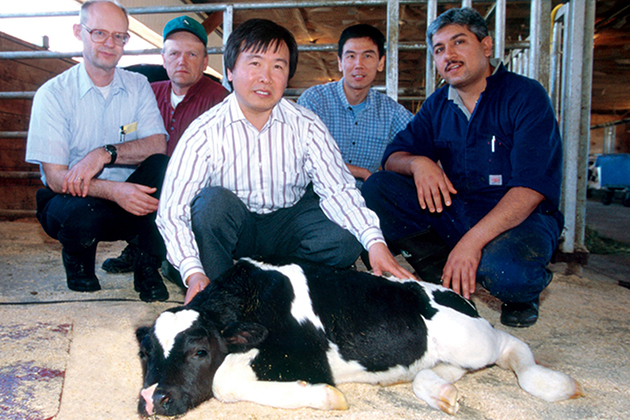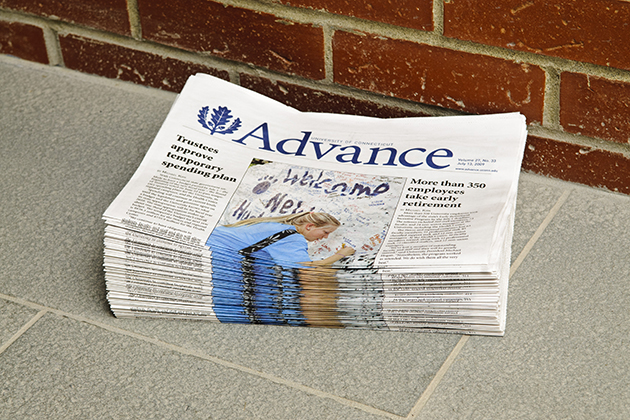Editor’s note: In celebration of Employee Appreciation Week, the University pauses to reflect upon and acknowledge the continuing effort and commitment shown by all members of the University community. You’ll find the name of UConn Today editor Elizabeth Omara-Otunnu on the list of those celebrating a major work anniversary with UConn this year.
The first description I heard of UConn was “There are no street lights and there are cows.” That was in the late 1980s, before the state’s sweeping infrastructure improvements got underway and before UConn researchers brought the first cloned cow into the world through cutting-edge science. But I had grown up in the English countryside, and I was not deterred.

My former husband and I had arrived in the U.S. two years previously with newly minted doctorates from Oxford, some boxes of books, and a baby. When he was being recruited by the UConn history department, we stayed in the faculty apartments at Lakeside, an attractive red brick house beside Swan Lake.
The warm welcome we received, the resources of the University, and the New England location, all fed into our decision to take the job offer and make our home in Storrs. We anticipated that it would be no more than three years before we moved on.

I initially worked at a state agency in Hartford, but was thrilled to be hired at UConn in 1993 as a university relations associate in what was then known as the Public Relations office. My place of work, the Publications Building on the corner of Dog Lane, was a single-story ‘temporary’ structure with a leaky roof, which was built in 1946 as a women’s gymnasium. Its only saving grace was the window boxes filled with flowers along Route 195. In its stead there now stands a multi-story building, part of the Storrs Center development, occupied on the first floor by Moe’s, Froyo World, and Dog Lane Café.
In the early years, summers on campus were so quiet that local businesses had a hard time staying open; and although the word was already out about UConn ice cream, it was served at a quaint 1950s-style Dairy Bar. Homer Babbidge Library was shrouded in plastic sheeting for many years because of structural problems. When it came time to register for classes, students had to stand in line, at least until touch-tone registration was introduced. And on Thursday evenings during the academic year, the campus emptied out, as the mostly Connecticut-born students left to spend the weekend at home.
There have always been outstanding students, faculty, and staff at the University, but when I began, the community lacked confidence in itself. When in the mid-1990s, after two years of planning, a group of far-sighted administrators, faculty, and students released a Strategic Plan that embraced the phrase ‘world class,’ there were many who felt such ambition was a stretch. However, the plan became the foundation for the University community to lobby the state to make a major investment in the campus infrastructure, and in June 1995 the $1 billion legislation known as UConn 2000 was signed into law.
While the University was still building support for its infrastructure proposal, my colleagues and I escorted reporters to some of the buildings in most egregious need of repair. Since then, I am privileged to have witnessed UConn’s epic transformation, and to have played a part in documenting – either through my own writing or through editing that of my colleagues – most of the major milestones along the way.
Even among the wide range of workplaces at UConn, University Communications is special. To begin with, the entire institution falls within our purview. What’s more, the very nature of our work involves interacting with inspiring educators, brilliant researchers, dedicated members of the community, and outstanding students, some of whom have a list of accomplishments so long that I have wondered if they have time to sleep.

My job has offered me the opportunity to delve into research on cicadas and fireflies, the science of blood-sucking leeches, invasive plant species, mercury in the environment, the molecular basis for vision, regeneration of the tropical rainforest, a disappearing language, and efforts to reduce violence among Hartford’s youth gangs, to name just a few.
Through my work, I have traced nationwide higher education trends as they played out at UConn. I helped document the shift from the old educational model of large lectures to pedagogy that emphasizes learning as well as teaching, the introduction of First Year Experience programs, Living and Learning Communities, the ‘Finish in Four’ initiative, and a new participatory and more accessible model of Study Abroad.
In 1997, I wrote an article announcing that UConn was ranked among the top 20 public universities for the first time. I also wrote about the integration of various forms of technology into teaching, including an article on the ‘Virtual Classroom’ when it was a novelty, and about University Libraries’ transition to providing online access to materials, through a period when many – incorrectly – anticipated the death of the book and the demise of the library.


Telling UConn stories has taken me around the state: I covered the opening of the magnificent new Law Library; highlighted the teacher education program in some of the state’s most challenging urban public schools; and helped promote the emerging identities of each regional campus.




My work has also introduced me to many unexpected treasures at UConn: specialists such as the scientific glassblower and the biology illustrator; exotic orchids in the EEB greenhouse; the UConn Forest; the student-run maple sugar shack; the annual chefs’ competition; the planetarium; and the carillon at Storrs Congregational Church that rings out across campus on many an afternoon.

I have attended presentations by outstanding speakers from across the nation and around the globe, from President Bill Clinton at the opening of the Dodd Research Center in 1995, to former Secretary of State Hillary Clinton in 2014; napalm survivor Kim Phuc, whose photo as a child during the Vietnam War horrified the world; and the renowned poet and author Maya Angelou. One of my most memorable interviews was with deep sea explorer Sylvia Earle, who spoke with great eloquence about the beauty of marine life and the importance of the oceans in the global ecosystem.
And at the culmination of each academic year, I have been on hand to witness and celebrate the graduation of thousands of UConn students, each class seemingly more accomplished than the last.

Along with the transformation of the University, the nature of my work has also evolved. When I became editor of the internal University tabloid newspaper, known as the UConn Advance, we still prepared camera-ready copy for the printer and the weekly publication cycle offered the satisfaction of finding a stack of newspapers on my desk each Friday morning, after working late the previous evening. When the men’s and women’s basketball teams played in the NCAA finals, we waited for the outcome and went to press in the middle of the night.
The UConn Advance first went online in 1997, just months before I became editor, but at that stage the online document was little more than a digital replica of the printed product. A couple of decades later, however, the online successor to the Advance, UConn Today, offers fresh content most days of the year in a variety of formats including video.

Even outside of work hours, the resources of the campus drew me back. Arts performances I have particularly enjoyed range from Beethoven’s 9th Symphony to Shakespeare’s Hamlet, Jesus Christ Superstar, and A Christmas Carol; the creation of a sand mandala by Tibetan Buddhist monks at the Benton Museum; and the opportunity to join in singing the chorus of Handel’s Messiah. A few years ago, I discovered a passion for growing my own food when I joined the student-run CSA at the Husky Ecogarden. And the winter seasons have been enlivened by Husky basketball.
As time passed, the toddler we’d first brought to campus was joined by a sister. Each spent some of her earliest years at the UConn daycare, Child Labs. While they were growing up, the girls – between them – learned to swim in Brundage Pool; practiced their cycling skills on campus sidewalks; mastered the fundamentals of ice skating at the old open-air rink; waded for frogs and tracked mice painted with luminescent dye in the dark on Museum of Natural History field trips; turned a potter’s wheel at the Community School for the Arts; learned the rudiments of polo from a national championship-winning coach; and stargazed from the top of Horsebarn Hill.

When it came time for our daughters to select a college, like many young people they hoped to spread their wings by attending a school far away from home. But after touring a number of other college campuses, the University of Connecticut looked better and better. Since then, each has written her own UConn story.
And me? I am still writing and editing for University Communications, in an office in the renovated Lakeside building, where I spent my first night on campus more than 25 years ago.





